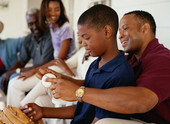
FRIDAY, April 26 (HealthDay News) — When the suspects in the Boston Marathon bombings were identified as two brothers — one of them a teenager — many parents wondered, “Who raised these boys?”
Mental health experts say it’s normal to want to blame parents or close relatives of young people whose violent acts lead to unfathomable tragedy, but in most cases, it’s just not that simple.
Did something in their family life influence Boston Marathon suspects Tamerlan Tsarnaev, 26, and his brother, Dzhokhar, 19? Could the parents of James Holmes — the suspect in last summer’s Aurora, Colo., movie theater shooting — or the mother of Sandy Hook Elementary School killer Adam Lanza have predicted and stopped such crimes?
The experts don’t think so.
“I don’t think it’s right to point a finger at the parent and say, ‘You caused a child to grow up and be a shooter,’ ” said psychologist Kenneth Dodge, director of the Center for Child and Family Policy at Duke University in Durham, N.C. “It’s much more complex than that.”
You can’t predict violence, added Dr. Catherine Mogil, co-director of Child and Family Trauma Service at the Nathanson Family Resilience Center at the UCLA Medical Center, in Los Angeles.
“If we could do that accurately, we’d be able to avoid these incidents,” Mogil said. “But we can look at people who have perpetrated violence and see what they have in common. And we can also look at the factors that help people grow up to lead happy, healthy lives.”
Factors that parents can’t control include genetic conditions such as depression and bipolar disorder, said Dr. Joanne Sotelo, division director of psychiatry at Scott & White Healthcare in Round Rock, Texas.
The earlier these issues are identified and treated, the better, Sotelo said.
“Most kids and adults have a normal range of anger and aggression,” Sotelo said. “But when you recognize that a kid is repeatedly expressing anger, whether they’re 3 or 10 years old, when violence is the main emotion they express — violence without necessarily being provoked — then you can’t ignore that. If you question if a behavior is normal, then it’s probably not.”
The family pediatrician is a good initial resource, she added. “He can address it if there is a developmental problem — symptoms of autism, Asperger’s or mental retardation, for example,” she said.
Prenatal exposure to drugs and alcohol also raises a child’s risk for violent behavior, too, Dodge said. High levels of lead in the blood also are linked to aggression and impulsive behavior.
But aggressive behavior doesn’t necessarily mean a child is trying to be malicious, Sotelo said. “Attention-Deficit/Hyperactivity Disorder (ADHD) and the impulsivity that comes with it, as well as mood changes from depression or anxiety, can look like aggression. It doesn’t mean a child is mean,” she said.
Sotelo suggested that parents connect with their school principal, a school counselor or nurse, or a local community health clinic or child services agency for support if their child shows aggression.
And Dodge said that parents can do a lot to set a positive, supportive environment at home that discourages such behavior.
“There are certain risk factors that have to do with parenting and the home environment,” he said. “One real risk factor is children’s exposure to violence and abuse. Children who experienced this in a home setting are at a greater risk for later violence.”
Dr. Stephen Leff, associate professor of clinical psychology in pediatrics at the University of Pennsylvania Perelman School of Medicine, said violent kids sometimes feel isolated at home and at school.
“Even if their parents are around, they may use punitive forms of discipline — they may not be strong adult role models,” Leff said. “Even one positive role model that they learn to trust and have good communication with when they’re frustrated can make a difference. Someone who can help them think through and become a problem-solver as opposed to a reactor.”
Having one good friend their age, or even older, also helps prevent aggressive behavior. “That can really buffer a child from a lot of negative repercussions,” Leff added.
Parents can think of their goal as building resilience in their children, and it starts as early as infancy, Mogil said.
“One of the things we know even about newborn babies is that when they’re picked up and nurtured they cry less in the second six months of life,” Mogil said. “They know someone will be there for them.”
Mogil said parents can weave resilient-behavior messages into everyday life. If you’re cut off in traffic, you might remark that that wasn’t smart, she said. But keep your cool. “Use those as teachable moments,” she added.
Family communication is key, Mogil said. As a child enters adolescence it is normal for them to separate. But stay available, she said, and be there for a hug or to talk about confusing life issues.
Resilient families usually get their kids involved in extracurricular activities that expose children to a network of other helpful adults — coaches, teachers and other parents, Mogil said.
Another simple tip: Limit your child’s exposure to violent imagery in video games, on television and online, Sotelo said.
“As parents, we might not be able to control everything. We can’t control their genetics, the personality traits they’re born with,” she said. “But early recognition of a problem, early diagnosis and treatment, and a supportive, loving home environment — that’s our biggest role in terms of prevention.”
More information
The U.S. National Institutes of Health has more about positive parenting.

